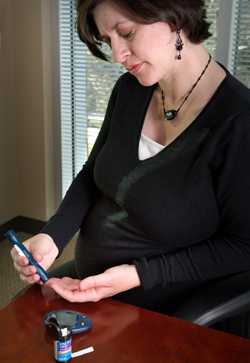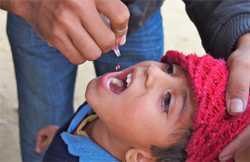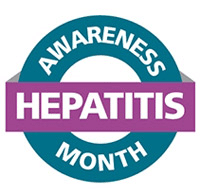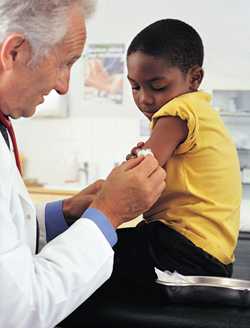CDC Newsroom
 ShareCompartir
ShareCompartir
Story Ideas - 2013
Jan
For Cervical Health Awareness Month learn more about the National Breast and Cervical Cancer Early Detection Program (NBCCEDP)

Through the National Breast and Cervical Cancer Early Detection Program (NBCCEDP), the Centers for Disease Control and Prevention (CDC) provides low-income, uninsured, and underserved women access to timely breast and cervical cancer screening and diagnostic services.
To improve access to screening, Congress passed the Breast and Cervical Cancer Mortality Prevention Act of 1990, which guided CDC in creating the NBCCEDP. Currently, the NBCCEDP funds all 50 states, the District of Columbia, 5 U.S. territories, and 11 American Indian/Alaska Native tribes or tribal organizations to provide screening services for breast and cervical cancer. The program helps low-income, uninsured, and underinsured women gain access to breast and cervical cancer screening, diagnostic and treatment services.
In 2000, Congress passed the Breast and Cervical Cancer Prevention and Treatment Act, which gives states the option to offer women diagnosed with cancer through the NBCCEDP access to treatment through Medicaid. To date, all 50 states and the District of Columbia have approved this Medicaid option. In 2001, with passage of the Native American Breast and Cervical Cancer Treatment Technical Amendment Act, Congress expanded this option to American Indians/Alaska Natives who are eligible for health services provided by the Indian Health Service or by a tribal organization.
Related Links:
For National Birth Defects Prevention Month educate your readers on managing gestational diabetes

Diabetes is often diagnosed in women during their childbearing years and can affect the health of both the woman and her unborn child. Poor control of diabetes during pregnancy increases the chances for problems [1.24 MB] for the woman and her baby. Control of blood sugar during pregnancy can help prevent those problems.
Gestational diabetes is first recognized in a pregnant woman who did not have diabetes before pregnancy. It shows up mid-pregnancy; hence testing is usually done at 24–28 weeks of pregnancy. Often gestational diabetes can be controlled through eating healthy foods and regular exercise, butsometimes insulin is needed, too.
To help control gestational diabetes
Eat healthy foods. Eat healthy foods from a meal plan made for a person with diabetes. A dietitian or certified diabetes educator can help you create a healthy meal plan.
Tasty Recipes for People with Diabetes and Their Families [1.1 MB]
Exercise regularly. Exercise is another way to keep blood sugar under control. It helps to balance food intake. After checking with your doctor, you can exercise regularly during and after pregnancy.
Learn more about physical activity during pregnancy »
Monitor blood sugar often. Because pregnancy causes the body’s need for energy to change, blood sugar levels can change very quickly. Check your blood sugar often, as directed by your doctor.
Get tested for diabetes after pregnancy. Get tested for diabetes 6 to 12 weeks after your baby is born, and then every 1 to 3 years. Gestational diabetes usually goes away soon after delivery. If not, the diabetes is called type 2 diabetes. Half of all women who had gestational diabetes develop type 2 diabetes later. It's important to continue to exercise and eat a healthy diet after pregnancy to prevent or delay getting type 2 diabetes.
To Find a Dietitian:
American Dietetic Association
1–800–877–1600
www.eatright.org (click on "Find a Nutrition Professional")
Related Links:
Feb
What to Know About Heart Attacks?!

A heart attack, also called a myocardial infarction, occurs when a section of the heart muscle dies or gets damaged because of reduced blood supply. Coronary Artery Disease (CAD) occurs when a substance called plaque builds up in the arteries that supply blood to the heart (called coronary arteries). CAD is the main cause of heart attack. The five major symptoms of a heart attack are—
- Pain or discomfort in the jaw, neck, or back.
- Feeling weak, light-headed, or faint.
- Chest pain or discomfort.
- Pain or discomfort in arms or shoulder.
- Shortness of breath.
If you believe you or someone are experiencing the symptoms of a heart attack it is important to to call 9-1-1 immediately. Otherwise, further damage to the heart muscle can occur and an irregular heart rhythm may develop.
Bystanders who have been trained to perform cardiopulmonary resuscitation (CPR) or use a defibrillator may be able to help the victim until emergency medical personnel arrive. At the hospital, doctors will then perform tests to determine whether a heart attack is occurring and decide on the best treatment.
Remember, it’s important to recognize these symptoms and call for help because the chances of surviving a heart attack are greater when emergency treatment begins quickly.
Related Links:
Visit these Web sites for additional information about heart-related conditions—
Mar
Hemophilia Awareness Month

Hemophilia is an inherited bleeding disorder in which the blood does not clot properly. This can lead to spontaneous bleeding as well as bleeding following injuries or surgery. Because the genetic mutation that causes hemophilia is carried in the X chromosome, men are more severely affected. However, some women (referred to as carriers of the hemophilia gene mutation) can also be affected.
Blood contains many proteins called clotting factors that help to stop bleeding. People with hemophilia have low levels of either factor VIII (8) or factor IX (9). Depending on how much clotting factor is in the blood, a person’s hemophilia may be mild, moderate, or severe.
The two most common types of hemophilia are:
- Hemophilia A (Classic Hemophilia) - This type is caused by a lack or decrease of clotting factor VIII.
- Hemophilia B (Christmas Disease) - This type is caused by a lack or decrease of clotting factor IX.
Hemophilia occurs in about 1 of every 5,000 male births. Currently, about 20,000 U.S. males are living with the disorder. Hemophilia A is about four times as common as hemophilia B and about half of those affected by Hemophilia A have the severe form of the disorder. Hemophilia affects people from all racial and ethnic groups.
The severity of hemophilia that a person has is determined by the level of the clotting factor in the blood. The lower the clotting level, the more likely it is that bleeding will occur that may lead to more serious complications.
Hemophilia can result in:
- Bleeding within joints that can lead to chronic joint disease and pain
- Bleeding in the head and sometimes in the brain, which can cause long-term problems such as seizures and paralysis
- Death can occur if the bleeding cannot be stopped or if it occurs in a vital organ such as the brain
The best way to treat hemophilia is to replace the missing blood clotting factor so that the blood can clot properly. This is done by infusing (giving medication by injection into a vein) commercially prepared factor concentrates.People with hemophilia can learn how to perform these infusions themselves so that they can stop bleeding episodes. By performing the infusions on a regular basis, people with hemophilia can also prevent most bleeding episodes.
Hemophilia is a complex disorder. Good quality medical care provided by doctors and nurses knowledgable about the disorder can help prevent serious problems. Often the best choice for this care is to visit a comprehensive Hemophilia Treatment Center (HTC). An HTC provides care to address all issues related to the disorder, and also, provides education that helps people with hemophilia stay healthy.
For more information:
TBI: What You Should Know

Traumatic brain injury (TBI) is a serious public health issue for Americans. Each year, TBI contributes to a substantial number of deaths and permanent disability. A TBI is caused by a bump, blow or jolt to the head or a penetrating head injury that disrupts the normal function of the brain. The severity of a TBI may range from "mild" to "severe".
According to research from CDC, approximately 3.5 million persons have a TBI in the United States. Of these individuals:
- 2.1 million received care in emergency departments,
- 300,000 were hospitalized,
- 84,000 were seen in outpatient departments,
- 1.1 million received care from office-based physicians, and
- 53,000 died.
Previously referred to as the "Silent Epidemic," individuals with this injury may not have any visible scars, and symptoms may not show up or be noticed until hours or days later. Still, a TBI can cause short or long-term problems se¬riously affecting thinking, learning, memory, and/or emotions. A TBI can affect all aspects of an individual’s life, as well as that of their loved ones. This may include relationships with family and friends, as well as their ability to work or be employed, do household tasks, or drive a car.
The most common causes of TBI are from falls and car crashes. While there is no one-size-fits all solution, there are many ways to reduce the chances of a TBI, including:
- Wearing a seat belt every time you drive or ride in a motor vehicle.
- Never driving while under the influence of alcohol or drugs.
- Avoiding activities that can distract you while you drive, such as using a cell phone, texting, and eating.
- Wearing a helmet and making sure your children wear helmets while riding a bike.
- Helping prevent falls by:
- Encouraging older adults to improve their balance and coordination by exercising.
- Using safety gates at the top and bottom of stairs to prevent young children from falling.
This March, in recognition of Brain Injury Awareness Month, CDC encourages you to learn more about TBI prevention at:
National Women and Girls HIV/AIDS Awareness Day

March 10 is National Women and Girls HIV/AIDS Awareness Day, a day to recognize the unique risks HIV and AIDS pose for women and girls, and to raise awareness of the disease's impact on them.
National Women and Girls HIV/AIDS Awareness Day is a time each year when organizations and communities across the United States come together to offer support, encourage discussion, and teach women and girls about HIV prevention, the importance of getting tested, and how to live with and manage HIV and AIDS, if they are HIV-infected.
The rate of new HIV infections among black women was 20 times as high as that of white women andnearly 5 times as high as that of Latina women in 2010. The rate of new HIV infections among Latinas was more than 4 times higher than white women. The reasons why black and Latina women are more affected by HIV and AIDS than women of other racial and ethnic groups are not directly related to race or ethnicity, but rather to the circumstances that often place some of these women and girls at greater risk of becoming infected with HIV. These circumstances may include higher rates of HIV and other sexually transmitted infections in communities of color, limited access to high-quality health care, economic disadvantages, stigma, fear, and discrimination.
CDC is committed to ensuring that all women, especially populations that are most heavily affected, are armed with the tools necessary to prevent HIV. For example, Take Charge. Take the Test is a multi-faceted communication campaign designed to increase HIV testing among black/African American women. This effort, which is part of CDC's national Act Against AIDS communication campaign, helps African American women recognize their risk of getting HIV and the need for HIV testing. It also empowers them by providing information, encourages them to get tested, and enables them to take charge of their lives—whatever their HIV test result.
There are several ways you can reduce your risk for getting HIV. Below are a few things you can do to look out for yourself and stay healthy.
- Don't have sex. Abstaining from sex means not having any type of sex at all—oral, anal, or vaginal. Abstinence is 100 percent effective in preventing sexual transmission of HIV.
- Practice mutual monogamy. Being sexually active with only one person who has agreed to be sexually active only with you is one of the best ways to protect yourself from HIV. Your chances of getting HIV will also be lower if both of you have recently tested negative for HIV. Also, talk to your partner about sex and HIV. Learn as much as you can about their past behavior (sex and drug use) and consider the risks to your health before you have sex.
- Use a condom. Using a latex condom every time you have oral, anal, or vaginal sex reduces your risk of HIV. Other forms of birth control don't protect you from getting HIV. Male and female condoms are the only effective form of birth control that also helps reduce the risk of transmission for HIV and most other STDs. If you do have sex, use a latex condom every time.
- Don't share certain items. Don't share needles, syringes and related works or anything else that might bring you into contact with someone else's blood or bodily fluids. HIV is not transmitted by casual contact, so it's ok to shake hands or share dishes with someone who is living with HIV.
- Don't use drugs or alcohol with sex. Don't have sex when you are taking drugs or drinking alcohol because being high or intoxicated can make you more likely to make unsafe sexual decisions.
- Get tested for STDs. If you think you may have been exposed to another STD such as gonorrhea, syphilis, or chlamydia, get tested. Studies show that STDs can facilitate both transmission and acquisition of HIV. So get tested (and treated, if necessary) for STDs. Find an STD testing site near you by typing your zip code into the testing site locator.
Make National Women and Girls HIV/AIDS Awareness Day a day to get the facts about HIV—to learn how HIV is spread, if you are at risk, and how to protect yourself and your loved ones. Take this opportunity to also get tested. HIV testing is the first critical step to knowing your status and protecting your health as well as protecting your partner. In fact, CDC recommends that all adults and adolescents be tested at least once in their lifetime and frequent testing for those individuals who practice more risky behaviors. And start talking openly about HIV. Speak to everyone you know about HIV – friends and family, coworkers and neighbors, at work and at places of worship. Have ongoing and open discussions with your partners about HIV testing and risk behaviors.
For more information:
- New HIV Infections in the United States [320.5 KB]
- CDC: HIV Among Youth
- Act Against AIDS
- Act Against AIDS campaign resources and basic information about HIV and AIDS.
- Take Charge. Take the Test.– This campaign targets African American women ages 18 to 34. Young African American women can take charge of their lives by knowing their HIV status – and by taking steps to protect themselves from HIV.
Apr
World Immunization Week: CDC Working 24/7 Worldwide

Every 20 seconds, a child dies from a disease that could be prevented with a safe and effective vaccine. Millions more children survive, but are left severely disabled. Vaccines have the power not only to save, but also transform lives by protecting against disease – giving children a chance to grow up healthy, go to school, and improve their lives. Vaccination campaigns sometimes provide the only contact with health care services that children receive in their early years of life.
Immunization is one of the most successful and cost-effective health interventions—it currently averts an estimated 2 to 3 million deaths every year in all age groups from diphtheria, tetanus, pertussis (whooping cough), and measles.
Immunization is a global health priority at CDC focusing on polio eradication, reducing measles deaths, and strengthening immunization systems. CDC works closely with a wide variety of partners in more than 60 countries to vaccinate children and provide technical assistance to ministries of health to strengthen and expand countries’ abilities to create, carry out, and evaluate their national immunization programs.
Too few people realize that the health of Americans and the health of people around the world are inextricably linked. Viruses don’t respect borders, so they travel easily within countries and across continents. By helping to stop vaccine-preventable diseases (VPDs) globally, CDC is also helping to protect people in the United States against importations of VPDs from other countries.
For example, in 2011, there were 220 reported cases of measles in the United States—200 of the 220 cases were brought into the U.S. from other countries with measles outbreaks.
The most effective and least expensive way to protect Americans from diseases and other health threats that begin overseas is to stop them before they spread to our shores. CDC works 24/7 to protect the American people from disease both in the United States and overseas. CDC has dedicated and caring experts in over 60 countries. They detect and control outbreaks at their source, saving lives and reducing healthcare costs. In 2012, CDC responded to over 200 outbreaks around the world, preventing disease spread to the U.S.
CDC's global health activities protect Americans at home and save lives abroad. They reduce the need for U.S. assistance and create goodwill and good relationships with global neighbors.
To learn more visit:
Binge Drinking: A Serious, Under-Recognized Problem among Women and Girls

April marks Alcohol Awareness Month, a nationwide campaign intended to raise awareness of the health and social problems that excessive alcohol consumption can cause for individuals, their families, and their communities. Excessive drinking is a dangerous behavior for both men and women. This year, CDC is drawing attention to the risks to women's health from binge drinking, the most common type of excessive alcohol consumption by adults.
According to a new Vital Signs report, more than 14 million U.S. women binge drink about 3 times a month, and consume an average of 6 drinks per binge. Drinking too much, including binge drinking (defined for women as consuming 4 or more drinks on an occasion) results in about 23,000 deaths in women and girls each year and increases the chances of breast cancer, heart disease, sexually transmitted diseases, unintended pregnancy, and many other health problems.
Despite these risks, about 1 in 8 adult women and 1 in 5 high school girls binge drink. Binge drinking is a problem for all women and girls, but it is most common in high school girls and young women, whites and Hispanics, and among women with household incomes of $75,000 or more. Half of all high school girls who drink alcohol report binge drinking.
For more information visit:
May
Hepatitis Awareness Month

CDC is leading a national education campaign initiative called Know More Hepatitis. The campaign aims to decrease the burden of chronic viral hepatitis by increasing awareness about this hidden epidemic and encouraging baby boomers (people born 1945-1965) to get tested.
Know More Hepatitis is being featured in May as part of Hepatitis Awareness Month. This year, May 19th will serve as the second Hepatitis Testing Day in the United States. Since chronic hepatitis often does not cause any symptoms until serious liver damage has been done, testing for hepatitis is crucial. Find out if you are at risk by taking a 5 minute online Hepatitis Risk Assessment.
This online assessment is designed to determine an individual’s risk for viral hepatitis by asking questions based on CDC’s guidelines for testing and vaccination. The Assessment allows individuals to answer questions privately and print their recommendations to discuss with their doctor.
The word "hepatitis" means inflammation of the liver. Hepatitis is most often caused by one of several viruses, which is why it is often called viral hepatitis. In the United States, the most common types of viral hepatitis are Hepatitis A, Hepatitis B and Hepatitis C.
Unlike Hepatitis A, which does not cause a long-term infection, Hepatitis B and Hepatitis C can become chronic, life-long infections. Chronic viral hepatitis can lead to serious liver problems including liver cancer. More than 1 million Americans are living with chronic Hepatitis B and 3 million with chronic Hepatitis C in the United States but most do not know they are infected. The vast majority of those infected with hepatitis C are baby boomers, or those born from 1945 through 1965. CDC recommends that everyone born during these years be tested for hepatitis C.
Both Hepatitis B and Hepatitis C can cause liver cancer and have contributed to the increase in rates of liver cancer in recent decades. Hepatitis C is a leading cause of liver cancer, which is the fastest-rising cause of cancer-related deaths in the U.S., as well as the most common indication for liver transplants. Hepatitis C is also responsible for more than 15,000 deaths each year (a number that has nearly doubled over the past decade).
With early detection, many people can get lifesaving care and treatment that can limit disease progression, and prevent cancer deaths. To find out if you should be tested take the Hepatitis Risk Assessment.
In addition, this month’s issue of Vital Signs focuses on hepatitis C testing, and suggests that only half of those with hepatitis C receive complete testing for the virus. For more information on the release, please visit the CDC Newsroom.
For more information:
National Asthma Awareness Month

Asthma is one of the most common lifelong chronic diseases. There are almost 26 million people living with asthma. The disease affects the lungs, causing repeated episodes of wheezing, breathlessness, chest tightness, and coughing. Although asthma cannot be cured, it is possible to manage asthma successfully to reduce and prevent asthma attacks, also called episodes. Successful asthma management includes knowing the warning signs of an attack, avoiding things that may trigger an attack, and following the advice of your healthcare provider. Using what you know about managing your asthma can give you control over this chronic disease. When you control your asthma, you will breathe better, be as active as you would like, sleep well, stay out of the hospital, and be free from coughing and wheezing. To learn more about how you can control your asthma, visit CDC's asthma site.
Asthma affects people of all ages and backgrounds. In most cases, we don't know what causes asthma, and we don't know how to cure it. Certain factors may make it more likely for one person to have asthma than another. If someone in your family has asthma, you are more likely to have it. Regular physical exams that include checking your lung function and checking for allergies can help your healthcare provider make the right diagnosis. With your healthcare provider's help, you can make your own asthma management plan so that you know what to do based on your own symptoms. Use your asthma medicine as prescribed and be aware of common triggers in the environment known to bring on asthma symptoms, including smoke (including second-hand and third-hand cigarette smoke), household pets, dust mites, and pollen. Limit or avoid exposure to these and other triggers whenever possible. The important thing to remember is that you can control your asthma.

For more information:
Jun
National Cancer Survivors Day

Millions of Americans are cancer survivors, living with, through, and beyond cancer. As the number of cancer survivors grows, CDC is working with partner organizations to help survivors throughout their cancer experience.
The Good News
People are living longer after a cancer diagnosis.
- Nearly 12 million Americans are alive after being told they have cancer.
- Due to medical advances, people are living many years after a cancer diagnosis.
- About two-thirds of people with cancer are expected to live at least 5 years after diagnosis.
Living With, Through, and Beyond Cancer
Cancer survivors often face physical, emotional, social, and financial challenges as a result of their cancer diagnosis and treatment. Also, survivors are at greater risk of having their first cancer recur, developing second cancers, and having other health conditions due to—
- The immediate and long-term effects of treatment.
- Behavioral risk factors (e.g., alcohol and tobacco use, sedentary behavior, dietary factors, and excessive sun exposure).
- Genetics.
- Environmental risk factors such as exposure to secondhand smoke, radon gas, asbestos, and certain chemicals.
Cancer survivorship affects not only the cancer patient, but also his or her family members, friends, and neighbors who provide support and help with daily tasks.
Learn more:
Jul
Arthritis

Arthritis affects 50 million adults and remains the most common cause of disability. Arthritis includes more than 100 different rheumatic diseases and conditions, the most common of which is osteoarthritis. Other frequently occurring forms of arthritis or other rheumatic conditions include rheumatoid arthritis, lupus, fibromyalgia, and gout. Although arthritis is more common among adults aged 65 years or older, most cases occur among those younger than age 65, and people of all ages (including children) can be affected. Arthritis is more common among women than men in every age group, and it affects members of all racial and ethnic groups. Arthritis is also more common among adults who are obese than among those who are normal weight or underweight.
What Can Be Done to Address Arthritis?
- Learn techniques to manage arthritis. Self-management education interventions such as the Arthritis Self-Management Program can teach people how to manage arthritis and lessen its effects. In multiple studies, this intervention was consistently found to improve people's health by reducing depression, fatigue, and health distress. More widespread use of this intervention and similar courses, such as the Chronic Disease Self-Management Program, which addresses arthritis along with other chronic diseases, will improve quality of life for people with arthritis.
- Be physically active. For people with arthritis, physical activities such as walking, bicycling, and swimming have been shown to have significant benefits, including reducing pain and improving physical function, mental health, and quality of life. The Walk with Ease Program, the Arthritis Foundation Exercise Program, and the Senior Services EnhanceFitness® program are three examples of community exercise interventions that have been shown to improve health among participants.
- Maintain a healthy weight and protect your joints. Weight control and injury prevention measures can lower a person's risk of developing osteoarthritis. Weight loss also can reduce symptoms for overweight or obese people with knee osteoarthritis.
- Consult a physician. Early diagnosis and appropriate management are especially important for people with inflammatory (red, hot, tender) arthritis. Consulting with a physician is also important because recommendations from health care providers are the most influential factor in convincing people to be physically active and to take an arthritis self-management course.
Watch out for the heat. The best defense is prevention. Those at greatest risk of heat-related illness include infants and children up to 4 years of age.
Be safe at home, work, and play
Most child injuries can be prevented. Injuries are the leading cause of death in children aged 19 and younger.
Stop the violence
Healthy relationship behaviors can have a positive effect on teens’ emotional development.
Check out more tips at Make Summer Safe for Kids. Help your loved ones and their friends have a safe and healthy summer!
Related Links:
Kid Safety this Summer

Help your kids stay safe and healthy while they enjoy summer fun! Teach them simple health tips at home and at play. Kids like to dive into summer to relax, unwind, and have fun. Warm weather brings more opportunity to enjoy the outdoors. Here are some ways to stay safe while enjoying swimming, boating, hiking, biking, and more.
Master healthy swimming
Swimming and other water activities are excellent ways to get the physical activity and health benefits needed for a healthy life. Get the most from vacation and learn how to keep yourself and your family safe while enjoying the water.
Beat the heat
Watch out for the heat. The best defense is prevention. Those at greatest risk of heat-related illness include infants and children up to 4 years of age.
Be safe at home, work, and play
Most child injuries can be prevented. Injuries are the leading cause of death in children aged 19 and younger.
Stop the violence
Healthy relationship behaviors can have a positive effect on teens’ emotional development.
Check out more tips at Make Summer Safe for Kids. Help your loved ones and their friends have a safe and healthy summer!
For more Information, please visit:
Managing Your Stress

Stress can hit you when you least expect it—before a test, after an accident, or during conflict in a relationship. It can occur during positive times (such as when planning a wedding) or following a difficult event (such as when dealing with the effects of a natural disaster). While everyone experiences stress at times, a prolonged bout of it can affect your health and ability to cope with life.
That’s why social support and self-care are important. They can help put your problems into perspective and ease stressful feelings. Follow CDC’s suggested tips for self-care.
Tips for Self-Care
The best ways to manage stress in hard times are through self-care:
- Avoid drugs and alcohol. They may seem to be a temporary fix to feel better, but in the long run they can create more problems and add to your stress—instead of take it away.
- Find support. Seek help from a partner, family member, friend, counselor, doctor, or clergyperson. Having a sympathetic, listening ear and sharing your problems and stress with someone really can lighten the burden and help you find solutions.
- Connect socially. After a stressful event, it is easy to isolate yourself. Spending time with loved ones and doing fun activities with your partner, children, or friends can help you and others heal and see that things are going to get better.
- Take care of yourself.
- Eat a healthy, well-balanced diet
- Exercise regularly
- Get plenty of sleep
- Take some time off if you feel stressed out—for example, treat yourself to a therapeutic massage or take a break from the news about stressful events.
- Maintain a normal routine
- Stay active. You can take your mind off your problems by giving— helping a neighbor, volunteering in the community, even taking the dog on a long walk. These can be positive ways to channel your feelings.
For more information, please visit:
Aug
Public Health Response to a Changing Climate

The changing climate endangers human health. Learn what CDC is doing to prevent and adapt to the possible health effects of climate change.
The environmental consequences of climate change are happening now and are expected to increase in the future. Signs of a changing climate include:
- sea-level rise,
- changes in precipitation causing flooding and drought,
- heat waves,
- more intense hurricanes and storms, and
- poor air quality.
Climate change affects human health both directly and indirectly.
The issue of climate change is broad and complex; addressing the health effects is challenging. CDC’s Climate and Health Program works to prevent and adapt to the possible health effects of climate change. The program identifies the populations most vulnerable to these impacts, predicts future trends, creates systems to detect and respond to emerging health threats, and designs programs to manage health risks now and in the future. The climate change funding for CDC represents the only U.S. Government investment dedicated to preparing our nation to anticipate and adapt to the health effects linked to climate change.
CDC funds the Climate-Ready States and Cities Initiative to strengthen the capabilities of state and local health agencies to deal with the challenges associated with climate change. Through CDC funding and technical support, sixteen state and two city health departments are applying advanced methods to address the health effects of climate change. As the nation's lead public health agency, CDC is using its prevention expertise to help state and city health departments investigate, prepare for, and respond to the health effects of a changing climate.
Additional information:
The State of Aging and Health in America 2013 Report Card

Twentieth-century advances in protecting and promoting health among older adults have provided many opportunities for overcoming the challenges of an aging society. The health indicators presented in The State of Aging and Health in America 2013 highlight these opportunities. By working to meet the goals for each of these key indicators, our nation can help to ensure that all of its citizens can look forward to living longer and living well.
The State of Aging and Health in America 2013 provides a snapshot of our nation’s progress in promoting prevention, improving the health and well-being of older adults, and reducing behaviors that contribute to premature death and disability. In addition, the report highlights mobility (referring to movement in all of its forms) and how optimal mobility is fundamental to healthy aging.
Demographic changes create an urgent need
The growth in the number and proportion of older adults is unprecedented in the history of the
United States. Two factors—longer life spans and aging baby boomers—will combine to double the
population of Americans aged 65 years or older during the next 25 years to about 72 million. By 2030,
older adults will account for roughly 20 percent of the U.S. population.
Chronic conditions present a strong economic incentive for action
During the past century, a major shift occurred in the leading causes of death for all age groups,
including older adults, from infectious diseases and acute illnesses to chronic diseases and degenerative
illnesses. More than a quarter of all Americans and two out of every three older Americans have
multiple chronic conditions, and treatment for this population accounts for 66 percent of the country’s health
care budget.
Related Links:
School Starts Soon—Is Your Child Fully Vaccinated?

School age children, from preschoolers to college students, need vaccines. CDC has online resources and tools to help parents and doctors make sure all kids are up-to-date on recommended vaccines and protected from serious diseases.
It's true that some vaccine-preventable diseases have become very rare thanks to vaccines. However, outbreaks still happen. For example, preliminary data through late July 2013 show that more than 10,000 cases of whooping cough (pertussis) have already been reported in this country and many more cases go unreported. Outbreaks of pertussis at middle and high schools can occur as protection from childhood vaccines fades.
Another disease that can spread very easily is measles. In 2013 so far, there have been about 130 reported cases of measles. Most of these people were not vaccinated or did not know their vaccination status. Measles is brought into the United States by unvaccinated U.S. residents and foreign travelers who get infected when they are in other countries. Measles is still common in parts of countries in Europe, Asia, the Pacific, and Africa. Measles can cause serious complications, such as pneumonia or inflammation of the brain, and even death. Infants and young children are at high risk for serious complications from measles.
As kids get older, protection from some childhood vaccines begins to wear off. Plus, older kids can also develop risks for other diseases. Back-to-school health check-ups and sports physicals can be a good opportunity for your preteens and teens to get the recommended vaccines. Making sure children and teens stay up-to-date with vaccinations is an important step in protecting them, their schoolmates, and our communities from unnecessary illness and deaths.
Related Links:
- CDC's Vaccine Website for Parents
- Parents' Guide to Childhood Immunizations
- Facts for Parents: Diseases and the Vaccines that Prevent Them
- State Mandates on Immunization and Vaccine-Preventable Diseases, Immunization Action Coalition
- Immunization Requirements for Child Care and School
- Links to State, City and Island Immunization or Public Health Department Websites
- If You Choose Not to Vaccinate Your Child, Understand the Risks and Responsibilities [PDF - 512 KB]
- Vaccination Records for Kids
- Vaccinations for Teens
Sep
Fruits and Vegetables

"Eat your fruits and vegetables." You've likely heard this statement since childhood. Research shows why it is good advice:
- Healthy diets rich in fruits and vegetables may reduce the risk of cancer and other chronic diseases.
- Fruits and vegetables also provide essential vitamins and minerals, fiber, and other substances that are important for good health.
- Most fruits and vegetables are naturally low in fat and calories and are filling.
Not sure how many fruits and vegetables you should be eating each day?
- Visit the Fruit and Vegetable Calculator. Here you can calculate your fruit and vegetable recommendations based on your calorie needs for your age, sex, and activity level. This site also has helpful tips and photographs of 1/2 cup and 1 cup fruit and vegetable examples.
- Ever wondered what counted as ½ a cup of grapes or celery without counting? Visit: What Counts as a Cup? This visual example of what counts as a cup helps simplify the answer.
- Want to know how much you need of each food group; including fruits and vegetables? Visit: MyPlate Daily Food Planto find out and receive a customized Daily Food Plan.
Curious as to whether fruits and vegetables can help you manage your weight?
- Take a look at this How to Use Fruits and Vegetables to Help Manage your Weight brochure and learn about fruits and vegetables and their role in your weight management plan. Tips to cut calories by substituting fruits and vegetables are included with meal-by-meal examples. You will also find snack ideas that are 100 calories or less. With these helpful tips, you will soon be on your way to adding more fruits and vegetables into your healthy eating plan.
Related Links:
Healthy Aging

Longer life spans and aging baby boomers will combine to double the population of older Americans to about 72 million by 2030. Heart disease, cancer, stroke, chronic lower respiratory diseases, Alzheimer’s disease and diabetes continue to be the leading causes of death among older adults.
State of Aging and Health in America 2013 [PDF - 3 MB] provides a snapshot of our nation’s progress in promoting prevention, improving the health and well-being of older adults, and reducing behaviors that contribute to premature death and disability. The report looks at 15 key health indicators that address health status (physically unhealthy days, frequent mental distress, oral health and disability); health behaviors (physical inactivity, nutrition, obesity and smoking); preventive care and screening (flu and pneumonia vaccine, breast and colorectal cancer screening); and fall injuries for Americans aged 65 years or older. As the baby boomer population ages, it is important to take steps to ensure older adults live long and healthy lives.
Get Screened
Less than half of men and women aged 65 years or older are up-to-date on preventive services including flu vaccine, pneumonia vaccine, colorectal cancer screening, and mammography for women.
Get Vaccinated
Flu and pneumonia is the seventh leading cause of death among adults 65 years or older, despite the availability of effective vaccines. Older adults should get the flu vaccine every year and get the pneumonia vaccine at least once.
Be Physically Active
Regular physical activity is one of the most important things older adults can do for their health. Physical activity can prevent many of the health problems that may come with age, including the risk of falls.
Eat Fruits and Vegetables Daily
Diets rich in fruits and vegetables may reduce the risk of some cancers and chronic diseases, such as diabetes and cardiovascular disease. Fruits and vegetables provide essential vitamins and minerals, fiber, and other substances that are important for good health.
Adults aged 65 years or older should eat 5 or more fruits and vegetables daily.
Quit Smoking
Tobacco use remains the single largest preventable cause of disease, disability, and death in the United States. For help quitting, visit www.smokefree.govor call 1-800-Quit-Now.
Take Medication for High Blood Pressure
High blood pressure is a major risk factor for cardiovascular disease, the leading cause of illness and death among older adults. Of the almost 67 million Americans with high blood pressure, more than half do not have it under control. Patients should take the initiative to monitor their blood pressure between medical visits, take medications as prescribed, tell their doctor about any side effects, and make lifestyle changes, such as eating a low-sodium diet, exercising, and stopping smoking.
Related Links
Suicide Prevention

Suicide can be prevented. Each year, more than 38,000 Americans take their own lives, an average of one suicide every 15 minutes. Suicide results in an estimated $45.8 billion in combined medical and work loss costs. September 10th is World Suicide Prevention Day. Help prevent suicide in your community.
Suicide (i.e., taking one's own life) is a serious public health problem that affects people of all ages. For Americans, suicide is the 10th leading cause of death. It resulted in 38,364 lives lost in 2010. The top three methods used in suicides included firearm (51%), suffocation (25%), and poisoning (17%).
Deaths from suicide are only part of the problem. More people survive suicide attempts than actually die. In 2011, about 487,700 people received medical care for self-inflicted injuries at emergency departments across the United States.
Several factors can put a person at risk for suicide. However, having these risk factors does not always mean that suicide will occur. Some of the risk factors identified by research include:
- History of previous suicide attempts
- Family history of suicide
- History of depression or other mental illness
- History of alcohol or drug abuse
- Stressful life event or loss
- Easy access to lethal methods
- Exposure to the suicidal behavior of others
Protective factors buffer individuals from suicidal thoughts and behavior. Some of the protective factors identified by research include:
- Skills in problem solving, conflict resolution, and nonviolent ways of handling disputes
- Effective clinical care for mental, physical, and substance abuse disorders
- Easy access to a variety of clinical interventions and support for help seeking
- Family and community support (connectedness)
- Support from ongoing medical and mental health care relationships
- Cultural beliefs that discourage suicide and support instincts for self-preservation, including seeking help
Most people are uncomfortable with the topic of suicide. Too often, victims are blamed and their families and friends are left stigmatized. As a result, people do not communicate openly about suicide. Thus, an important public health problem is left shrouded in secrecy, which limits the amount of information available to those working to prevent suicidal behavior.
Know the Warning Signs and Get Help
Suicide has many warning signs. For more information, visit the Web site for American Association of Suicidology.
The good news is that research over the last several decades has uncovered a wealth of information about the causes of suicide and prevention strategies. Additionally, CDC is working to monitor the problem, develop and evaluate prevention strategies, and to disseminate information to prevent suicidal behavior.
If you or someone you know is having thoughts of suicide, contact the National Suicide Prevention Lifeline at 1-800-273-TALK (1-800-273-8255) or visit the National Suicide Prevention Lifeline website.
More Information
Oct
Intimate Partner Violence as a Public Health Problem
Intimate partner violence (IPV) includes physical violence, sexual violence, threats of physical or sexual violence, and emotional abuse by a current or former spouse or non-marital partner. IPV exists along a continuum from a single episode of violence to ongoing battering.
IPV facts:
- More than 1 in 4 women and 1 in 10 men in the United States have experienced rape, physical violence, or stalking by a partner and report that the violence impacted them in some way (e.g., made them feel fearful or concerned for their safety, resulted in an injury or need for services, or they lost days from work or school).
- Nearly 10% of U.S. women have been raped by an intimate partner in their lifetime.
- 1 in 4 women and 1 in 7 men have experienced severe physical violence by an intimate partner (e.g., hit with a fist or something hard, kicked, beaten, burned, or had a knife or gun used against them).
- IPV resulted in 1,336 deaths in 2010—accounting for 10% of all homicides. Eighty-two percent of these deaths were females and 18% were males
- The medical care, mental health services, and lost productivity (e.g., time away from work) cost of IPV was an estimated $5.8 billion in 1995. Updated to 2003 dollars, that’s more than $8.3 billion.
Related Links
- Intimate Partner Violence homepage
- Public Health's Role in Intimate Partner Violence Prevention
National Intimate Partner and Sexual Violence Survey - Dating Matters Initiative
- Training Professionals in the Primary Prevention of Sexual and Intimate Partner Violence: A Planning Guide
Breast Cancer Awareness Month
If you are a woman age 50 to 74 years, be sure to have a screening mammogram every two years. If you are age 40–49 years, talk to your doctor about when and how often you should have a screening mammogram.
Is breast cancer the most common cause of death for women?
No. Although many women get breast cancer, it is not a common cause of death. Heart disease is the number one cause of death among women age 40 and above, followed by stroke, lung cancer, and lung diseases. Breast cancer is the fifth leading cause of death.
What is a mammogram?
A mammogram is an X-ray of the breast. Doctors use a mammogram to look for early signs of breast cancer. Having regular mammograms can lower the risk of dying from breast cancer.
Why should I have a mammogram?
Related Links
Nov
COPD Awareness Month

Chronic Obstructive Pulmonary Disease, or COPD, refers to a group of diseases, including emphysema, chronic bronchitis, and in some cases asthma, that cause airflow blockage and breathing-related problems.. In the United States, tobacco smoke is a key factor in the development and progression of COPD. Exposure to air pollutants in the home and workplace, genetic factors, and respiratory infections also play a role in COPD. In the developing world, indoor air quality is thought to play a larger role in the development and progression of COPD than it does in the United States.
Avoid inhaling tobacco smoke, home and workplace air pollutants, and respiratory infections to prevent developing COPD. Early detection of COPD might change its course and progress. A simple test called spirometry can be used to measure pulmonary—or lung—function and detect COPD in anyone with breathing problems. Treatment of COPD requires a careful and thorough evaluation by a physician. COPD treatment can alleviate symptoms, decrease the frequency and severity of exacerbations, and increase exercise tolerance.
For those who smoke, the most important aspect of treatment is smoking cessation. Tobacco smoke and removing other air pollutants from the patient’s home or workplace are also important. Symptoms such as coughing or wheezing can be treated with medication. Pulmonary rehabilitation is an individualized treatment program that teaches COPD management strategies to increase quality of life. Plans may include breathing strategies, energy-conserving techniques, and nutritional counseling. The flu can cause serious problems in people with COPD. Vaccination during flu season is recommended and respiratory infections should be treated with antibiotics, if appropriate. Patients who have low blood oxygen levels are often given supplemental oxygen.
To learn more about COPD, visit
- Easy Breathing (A Cup of Health with CDC)
- Learn More Breathe Better
- National Heart Lung and Blood Institute's 'Learn More Breathe Better'
- COPD Foundation
- American Lung Association
- Global Initiative for Chronic Obstructive Lung Disease
Lung Cancer Awareness Month

Lung cancer is the leading cause of cancer deaths in both men and women. Smoking causes 80 to 90 percent of cases of lung cancer. Each year, about 200,000 people are told they have lung cancer and more than 150,000 people die from this disease in the United States. Deaths from lung cancer represent about one out of every six deaths from cancer in the United States.
Research has found several causes and risk factors for lung cancer. A risk factor is anything that changes the chance of getting a disease. Lung cancer risk factors include—
- Smoking.
- Breathing secondhand tobacco smoke. (Not just cigarettes, but all tobacco smoke…)
- Radon gas in the home.
- Things around home or work, including asbestos, ionizing radiation, and other cancer-causing substances.
- Medical exposure to radiation to the chest.
- Chronic lung disease such as emphysema or chronic bronchitis.
- Increased age.
You can reduce your risk of developing lung cancer in several ways.
- Don’t smoke. If you do smoke, quit now. The sooner you stop, the sooner your body can begin to heal, and the less likely you are to get sick from tobacco use.
- Getting help through counseling or medications can double or triple the chances for quitting.
- Call 1-800-QUIT-NOW for free help quitting and go to www.cdc.gov/tips for additional quit support and real stories of people who have quit successfully.
- Avoid secondhand smoke. Make your home and vehicles smoke-free.
- Have your home tested for radon and take corrective actions if high levels are found.
- Be aware of your exposure to radiation from medical imaging. Ask your doctor about the need for medical tests that involve images of the chest.
- Follow health and safety guidelines in the workplace when working with toxic materials.
- Avoid diesel exhaust and other harmful air pollutants.
Lung cancer is treated in several ways, depending on the type of lung cancer and how far it has spread. . People with lung cancer often get more than one kind of treatment that includes surgery, chemotherapy, and radiation. People with lung cancer may want to take part in a clinical trial. Clinical trials study new potential treatment options. Learn more about clinical trials at the National Cancer Institute.
More Information
Family Caregivers

If you are a family member who cares for someone with a disability, whether a child or an adult, combining personal, caregiving, and everyday needs can be challenging. This site has information for family caregivers to help those you care for stay safe and healthy. These general caregiving tips provide families with information on how to stay healthy and positive. Keep in mind that these tips can be used to address many family issues. Information, support, advocacy, empowerment, care, and balance can be the foundation for a healthy family and are appropriate no matter what the challenge.
Be Informed
- Gather information about your family member's condition, and discuss issues with others involved in the care of your family member. Being informed will help you make more knowledgeable health decisions and improve your understanding about any challenges your family might face. Notice how others care for the person with special needs. Be aware of signs of mental or physical abuse.
Get Support
- Family members and friends can provide support in a variety of ways and oftentimes want to help. Determine if there are big or small things they can do to assist you and your family.
- Join a local or online support group.
Be an Advocate
- Be an advocate for your family member with a disability. Caregivers who are effective advocates may be more successful at getting better service.
- Ask questions.
- Inform other caregivers of any special conditions or circumstances. Document the medical history of your family member with a disability, and keep this information current.
- Make sure your employer understands your circumstances and limitations. Discuss your ability to travel or to work weekends or evenings. Arrange for flexible scheduling when needed.
- Become familiar with the Americans with Disabilities Act, the Family Medical Leave Act, and other state and national provisions. Know how and when to apply them to your situation.
Be Empowering
- Focus on what you and your family member with a disability can do. Find appropriate milestones and celebrate them.
- If someone asks you questions about the family member with a disability, let him or her answer when possible. Doing so may help empower the individual to engage with others.
- When appropriate, teach your family member with a disability to be as independent and self-assured as possible. Always keep health and safety issues in mind.
Take Care of Yourself
- Take care of yourself. Caring for a family member with a disability can wear out even the strongest caregiver. Stay healthy for yourself and those you care for.
- Delegate some caregiving tasks to other reliable people.
- Take a break. Short breaks, like an evening walk or relaxing bath, are essential. Long breaks are nurturing. Arrange a retreat with friends or get away with a significant other when appropriate.
Keep Balance in the Family
- Family members with a disability may require extra care and attention. Take time for all family members, taking into account the needs of each individual. For example, it’s important for parents of a child with a disability to also spend time with each other and with any other children they might have.
- Consider respite care. "Respite" refers to short-term, temporary care provided to people with disabilities so that their families can take a break from the daily routine of caregiving.
For More Information
Caregiving Resources
Find more information and resources on caregiving, including tip sheets and links to organizations and networks that can provide support, including the following:
- Resources from the Office on Disability, U.S. Department of Health and Human Services
- Advocating for your family member with a disability
- Benefits for children with disabilities (Social Security Administration)
- Disability Resource Locator
- Education resources
- Federal Resources on Disability and Health
- Health and Human Services (includes Medicare/Medicaid services)
National Epilepsy Awareness Month

November is National Epilepsy Awareness Month. Epilepsy affects about 2 million people in the United States and is characterized by recurrent, unprovoked seizures. Delayed recognition of these seizures and inadequate treatment increases the risk for additional seizures, disability,decreased health-related quality of life and, in rare instances, death.
Although epilepsy can occur at any age, the condition is more likely to begin among children less than 2 years of age and adults older than 65 years. As do many who live with other chronic disorders, those with epilepsy often face challenges related to managing epilepsy treatment, symptoms, disability, lifestyle limitations, emotional stress, and stigma.
CDC’s Managing Epilepsy Well (MEW) Network is composed of individuals interested in improving the care of people with epilepsy. MEW Network members, including representatives from U.S. universities, community-based organizations, and CDC are working together to develop and test self-management programs and tools that help people with epilepsy better manage their disorder and improve their quality of life.
MEW programs available to communities include WebEase, UPLIFT, and PEARLS. WebEase (Epilepsy Awareness Support and Education) is an internet self-management program designed to improve medication adherence, stress management, and sleep. UPLIFT (Using Practice and Learning to Increase Favorable Thoughts) is an internet and telephone program that combines cognitive behavioral therapy with mindfulness to treat depression in people with epilepsy. PEARLS (Program to Encourage Active Rewarding Lives) is a home-based, collaborative-care depression treatment program for adults with epilepsy.
Interventions that are currently being tested by MEW network researchers include a self-management program that combines self-regulation and social support for adults with refractory epilepsy; an electronic decision-support system for clinics to improve self-management communication and behavior; and a consumer-driven self-management program. New projects include a telephone intervention for rural dwelling adults with epilepsy and cognitive impairment, and self-management training for adults with epilepsy and co-existing serious mental illness.
More Information
- Learn more about the MEW Network.
- Find additional information on epilepsy.
- Learn about epilepsy first-aid.
Dec
Stay Safe on the Roads This Holiday Season

This holiday season, and all year, keep safety in mind whenever you're on the road.
Tips from CDC's Injury Center on motor vehicle safety can help you protect yourself, your passengers, and your family and friends. Whether you're headed around town, out-of-town, or out to celebrate, we wish you a safe holiday season.
Protect Your Passengers
Whenever you're on the road this holiday season, remember to always buckle up. Wearing your seat belt can reduce your risk of death or serious injury in a crash by about half. For children 12 and under, the safest place to ride is properly buckled in the back seat in age- and size-appropriate car seats, booster seats, or seat belts. Car seats reduce the risk of death in car crashes by 71 percent for infants and 54 percent for toddlers ages 1 to 4. Booster seat use reduces the risk for serious injury by 45 percent for children aged 4–8 years, when compared with seat belt use alone.
Learn more about child passenger safety and CDC's research and activities in this area.
Celebrate Safely
During the holiday season, and year-round, take steps to make sure that you and everyone you celebrate with avoids driving under the influence of alcohol. Following these tips can help you stay safe:
- Plan ahead. Always designate a non-drinking driver before any holiday party or celebration begins.
- Take the keys. Don't let friends drive if they are impaired.
- Be a helpful host. If you're hosting a party this holiday season, remind your guests to plan ahead and designate their sober driver; offer alcohol-free beverages; and make sure all of your guests leave with a sober driver.
Learn more about alcohol-impaired driving and CDC's research and activities in this area.
Related Links
Get email updates
To receive email updates about this site, enter your email address:
Contact Us:
- Centers for Disease Control and Prevention
1600 Clifton Rd
Atlanta, GA 30333 - 800-CDC-INFO
(800-232-4636)
TTY: (888) 232-6348 - Contact CDC-INFO



